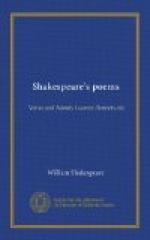
|
| Name: _________________________ | Period: ___________________ |
This test consists of 15 multiple choice questions and 5 short answer questions.
Multiple Choice Questions
1. What does Adonis tell Venus he primarily objects to about her professions of love?
(a) They are embarrassing.
(b) They are callous.
(c) They are dishonest.
(d) They are unfeminine.
2. Whom does Venus address as a "clear god" (line 860)?
(a) The wind.
(b) The sun.
(c) The morning.
(d) The sky.
3. What technique is used in line 645, "Grew I not faint, and fell I not downright"?
(a) Parallelism.
(b) Chiasmus.
(c) Anadiplosis.
(d) Antistrophe.
4. What critique does the speaker offer of Venus's song?
(a) It is out of tune.
(b) It exaggerates her feelings.
(c) It is immodest.
(d) It is long and boring.
5. What does line 972 compare to "many clouds consulting for foul weather"?
(a) The events leading to Adonis's death.
(b) Venus's emotions.
(c) The howling dogs.
(d) The years Venus will live without Adonis.
6. In the simile discussing the impact of an earthquake on a king's subjects, what does the speaker say causes earthquakes?
(a) Wind trapped in the ground.
(b) Shifting tectonic plates.
(c) Disturbed rotation of the earth.
(d) God's wrath.
7. What is making the sounds referred to in lines 847 and 848, "For who hath she to spend the night withal,/ But idle sounds resembling parasites"?
(a) Birds.
(b) Bugs.
(c) Caves.
(d) The night.
8. What is the most logical definition of "tushes" in the context of line 617, "Whose tushes never sheath’d he whetteth still"?
(a) Tusks.
(b) Touches.
(c) Knives.
(d) Hooves.
9. What technique is used in lines 647 and 648, "My boding heart pants, beats, and takes no rest,/ But like an earthquake, shakes thee on my breast"?
(a) Diacope.
(b) Malapropism.
(c) Euphony.
(d) Simile.
10. Why does Venus ask Adonis whether he saw her grow pale and tremble when he mentioned hunting boar?
(a) She hopes he will be aroused by her display of feminine "weakness."
(b) She is stressing that she knows what she is talking about.
(c) She hopes he will feel sympathy for her.
(d) She considers this evidence that she is not lying about her fear.
11. What technique is used in line 1026, "Whereat she leaps that was but late forlorn"?
(a) Consonance.
(b) Oxymoron.
(c) Metaphor.
(d) Innuendo.
12. What is Venus's motive for flattering death?
(a) She hopes it will keep death from taking Adonis.
(b) She fears that death will try to take her life, too.
(c) She is relieved and her natural flirtatiousness returns.
(d) She feels genuinely sorry that she has accused him.
13. What technique is used in line 1138, "Find sweet beginning, but unsavoury end"?
(a) Antithesis.
(b) Paralepsis.
(c) Chiasmus.
(d) Anthimeria.
14. What is the best definition of "eyne" in line 633, "Nor thy soft hands, sweet lips, and crystal eyne"?
(a) Eyes.
(b) Voice.
(c) Breath.
(d) Skin.
15. What are the various forms of repetition in lines 833 and 834, "'Ay me!' she cries, and twenty times, 'Woe, woe!'/ And twenty echoes twenty times cry so," meant to convey?
(a) The repetition highlights the difference between Venus's display of grief and the shallowness of her real feelings.
(b) The repetition stresses Venus's passion and mimics the sound of echoing.
(c) The repetition demonstrates that Venus's lust has become genuine love.
(d) The repetition mimics the way Venus keeps running back and forth looking for Adonis.
Short Answer Questions
1. To what does Venus compare the fear of a person in love?
2. What technique is used in lines 629 and 630, "The thorny brambles and embracing bushes/ As fearful of him, part"?
3. What characteristic of the boar does Venus's description primarily stress?
4. What does Venus say the boar is looking for with its "downward eye" (line 1106)?
5. What technique is used in line 899, "Bids them leave quaking, bids them fear no more"?
|
This section contains 630 words (approx. 3 pages at 300 words per page) |

|




